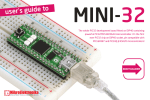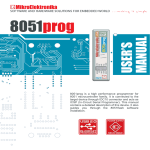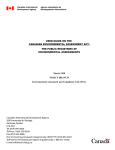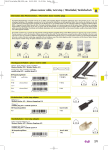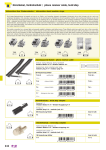Download 8051Flash Programmer User Manual
Transcript
8051Flash Programmer If you have any questions, comments or business proposals, do not hesitate to contact us at [email protected] If you are experiencing some problems with any of our products or just need additional information, please place your ticket at www.mikroe.com/en/support If you want to learn more about our products, please visit our website at www.mikroe.com ™ User manual Flash program is used to transfer a .hex file from a PC to the microcontroller memory by means of the appropriate hardware. Every flash program includes numerous options used for setting the microcontroller’s configuration bits. DISCLAIMER All the products owned by MikroElektronika are protected by copyright law and international copyright treaty. Therefore, this manual is to be treated as any other copyright material. No part of this manual, including product and software described herein, may be reproduced, stored in a retrieval system, translated or transmitted in any form or by any means, without the prior written permission of MikroElektronika. The manual PDF edition can be printed for private or local use, but not for distribution. Any modification of this manual is prohibited. TO OUR VALUED CUSTOMERS I want to express my thanks to you for being interested in our products and for having confidence in Mikroelektronika. The primary aim of our company is to design and produce high quality electronic products and to constantly improve the performance thereof in order to better suit your needs. Nebojsa Matic General Manager MikroElektronika provides this manual ‘as is’ without warranty of any kind, either expressed or implied, including, but not limited to, the implied warranties or conditions of merchantability or fitness for a particular purpose. MikroElektronika shall assume no responsibility or liability for any errors, omissions and inaccuracies that may appear in this manual. In no event shall MikroElektronika, its directors, officers, employees or distributors be liable for any indirect, specific, incidental or consequential damages (including damages for loss of business profits and business information, business interruption or any other pecuniary loss) arising out of the use of this manual or product, even if MikroElektronika has been advised of the possibility of such damages. MikroElektronika reserves the right to change information contained in this manual at any time without prior notice, if necessary. HIGH RISK ACTIVITIES The products of MikroElektronika are not fault – tolerant nor designed, manufactured or intended for use or resale as on – line control equipment in hazardous environments requiring fail – safe performance, such as in the operation of nuclear facilities, aircraft navigation or communication systems, air traffic control, direct life support machines or weapons systems in which the failure of Software could lead directly to death, personal injury or severe physical or environmental damage (‘High Risk Activities’). MikroElektronika and its suppliers specifically disclaim any expressed or implied warranty of fitness for High Risk Activities. TRADEMARKS The Mikroelektronika name and logo, the Mikroelektronika logo, mikroC, mikroC PRO, mikroBasic, mikroBasic PRO, mikroPascal, mikroPascal PRO, AVRflash, PICflash, dsPICprog, 18FJprog, PSOCprog, AVRprog, 8051prog, ARMflash, EasyPIC5, EasyPIC6, BigPIC5, BigPIC6, dsPIC PRO4, Easy8051B, EasyARM, EasyAVR5, EasyAVR6, BigAVR2, EasydsPIC4A, EasyPSoC4, EasyVR Stamp LV18FJ, LV24-33A, LV32MX, PIC32MX4 MultiMedia Board, PICPLC16, PICPLC8 PICPLC4, SmartGSM/GPRS, UNI-DS are trademarks of Mikroelektronika. All other trademarks mentioned herein are property of their respective companies. All other product and corporate names appearing in this manual may or may not be registered trademarks or copyrights of their respective companies, and are only used for identification or explanation and to the owners’ benefit, with no intent to infringe. The Atmel name and logo, the Atmel logo, AVR, AVR (Logo), AVR Freaks, AVR Freaks (Logo), AVR Studio, IDIC, megaAVR, megaAVR (Logo), picoPower ®, tinyAVR ® are trademarks of Atmel Coorporation. ©MikroelektronikaTM, 2010, All Rights Reserved. page 8051Flash TABLE OF CONTENTS 1.0. Introduction to 8051prog Programmer ...................................................................................... 4 2.0. Programming Microcontrollers .................................................................................................. 5 3.0. 8051Flash Program ................................................................................................................... 6 4.0. Software Installation .................................................................................................................. 7 5.0. Practical Example of Using 8051Flash Program ....................................................................... 9 6.0. Keyboard Shortcuts and Command Line Parameters ...............................................................10 MikroElektronika page 8051Flash 1.0. Introduction to 8051prog Programmer The 8051prog™ programmer is a great tool used for programming 8051 microcontrollers from Atmel®. As a low-consumption device, it is ideal to be used with notebooks. It’s unique design and simplicity make it a very popular tool among beginners and professional users alike. The 8051prog programmer communicates to the microcontroller through a USB cable which is also used for powering the programmer. In order to use this programmer, it is necessary to have the 8051Flash program and the appropriate driver, provided on the product CD, installed on your PC. After that, you can use the 8051prog programmer and a hex code generated in any 8051 compiler to load the program into an 8051 microcontroller. The 8051prog programmer is built into all Mikroelektronika’s 8051 development systems. The same programmer is also available as a stand-alone device used for programming 8051 microcontrollers built into (soldered on) the target device. The 8051prog programmer is built into all Mikroelektronika’s development systems designed for working with 8051 microcontrollers. The 8051prog programmer is also available as a standalone device used for programming 8051 microcontrollers built into (soldered on) the target device. Figure 1-1: On-board 8051prog programmer Figure 1-2: Stand-alone 8051prog programmer The 8051Flash program contains an option for selecting the microcontroller to be programmed. The latest version of this software with updated list of supported microcontrollers can be downloaded free of charge from our website at www.mikroe.com Figure 1-3: 8051Flash program’s window MikroElektronika page 8051Flash 2.0. Programming Microcontrollers The process of programming microcontrollers starts by writing a program in one of 8051 compilers (mikroC PRO for 8051, mikroBASIC PRO for 8051, mikroPASCAL PRO for 8051 etc.). When the program is correctly written, it should be compiled into a format that can be loaded into the microcontroller. The program to be loaded into the microcontroller has the .hex extension. As soon as the .hex file is generated, the program can be loaded into the microcontroller. Compiling program Loading hex code 1 3 2 1 Write a code in one of 8051 compilers and generate a .hex file; 2 In the 8051Flash program’s main window select the microcontroller and load the hex code into the programmer’s buffer; 3 Click the Write button to program the microcontroller. On the right side of the 8051Flash program’s window there are several options which make the programming process easier, whereas, on the left side of the window there are a number of options for microcontroller settings. Positioned in the bottom right corner of the window, the Progress bar enables you to monitor the programming process. MikroElektronika page 8051Flash 3.0. 8051Flash Program The 8051Flash program is easy to use as all the options necessary for its operation are provided in a simple window which will appear either by clicking on the 8051FLASH icon or automatically by starting the programming process (Build And Program option) in one of 8051 compilers. The options used for setting configuration bits are provided on the left side of the window, whereas the options for loading .hex file into the programmer and microcontroller are provided on the right side of the window. The left side of the window can be different depending on the type of the microcontroller in use and its configuration bits. To load the program into the microcontroller, do the following: 1 1 3 Select the microcontroller to be programmed and the 8051Flash will automatically set default parameters for working with the respective microcontroller 2 Click the Load option to open the window to select the hex code to be loaded into the microcontroller 2 3 Click the Write option to start programming the microcontroller The Progress bar shows the programming progress expressed in a percentage Figure 3-1: 8051Flash program’s main window The 8051Flash program enables a hex code, generated in some of 8051 compilers, to be loaded into the microcontroller. The hex code should be loaded first into the programmer’s buffer by clicking the Load option, then into the microcontroller by clicking the Write option within the programmer’s main window. The programming progress will be shown in the Progress bar positioned in the bottom right corner of the same window. MikroElektronika page 8051Flash 4.0. Software Installation Before you use the 8051Flash program, it is necessary to install the appropriate driver. For more information refer to quick guide for installing USB drivers. Step 1: Start installation Insert the product CD into a CD drive. After a few seconds, a list with all Mikroelektronika’s products will appear on the screen. To start the process of installing the 8051Flash software, click on the setup icon provided in the 8051prog section on the product CD: CD Drive:/zip/8051flash_programmer.zip You can also download the 8051Flash free of charge from our website. In this case the installation starts from your hard drive. A welcome window appears. Click Next to proceed. Step 2: License Agreement Before you start the installation process, please review the license agreement terms. To accept them, select the option I accept the terms in the License Agreement and click Next. Step 3: Choose Components To make your choice simple, this installation step offers you only one component to choose. Click Next. MikroElektronika page 8051Flash Step 4: Choose Installation Location Now, you should specify the folder to install the 8051Flash program into. If you want to install it in a folder different from default, click Browse and select another folder on your hard disc. Then click Next. If you choose the default folder, the program will be installed on the following location: C:\Program Files\Mikroelektronika\8051FLASH\ Step 5: Installation Details The installation of the 8051Flash program starts immediately. The installation progress will be shown on the screen. If you are interested in details about the installation, click the Show details button. Step 6: Completing Installation Windows will inform you in the window, as shown in figure on the right, that the 8051Flash program has been successfully installed. Click Finish to complete the installation. MikroElektronika page 8051Flash 5.0. Practical Example of Using 8051Flash Program After the software installation is complete, connect the programmer to your development system using a USB cable. The USB connection will be automatically established, which is indicated by the USB LINK LED’s illumination. Step 1: Start up the 8051Flash program Start up the 8051Flash program installed on your PC. Click the Device option in order to select the microcontroller to be programmed. The 8051Flash program will automatically set default parameters for working with the respective microcontroller. Step 2: Load a hex code into programmer’s buffer Click the Load option to open the Open window, as shown in figure on the right. Select the relevant file with the .hex extension and click the Open button. The file will be automatically loaded into the programmer’s buffer. Step 3: Write the hex code into the microcontroller Click the Write option in the upper right corner of the main window to start programming the microcontroller. The programming progress will be shown in the bottom right corner of the same window. MikroElektronika page 10 8051Flash 6.0. Keyboard Shortcuts and Command Line Parameters Keyboard Shortcuts: Alt-E Alt-W Alt-V Alt-R Alt-D Ctrl-S Ctrl-O Ctrl-R Command Line: The 8051Flash program may also be activated from the command line, thus enabling you to use it from some other software, compiler etc. Here is a list of the command line parameters: -w -v -e -r -p -f -fc -fd -c -q Example 1: 8051Flash.exe -w -pAT89S8253 -v -f”C:\somefile.hex” Erase the content of microcontroller’s memory Write a hex code into an 8051 microcontroller Verify the loaded hex code Program memory reading Change microcontroller type Save hex code Open (Load) file with hex code Reload hex code Write to 8051 microcontroller Verify Erase program from 8051 microcontroller Read program from 8051 microcontroller Type of microcontroller (for example AT89S8253) .hex file name “[<name must be enclosed in quotation marks>]” .hex file name to be loaded into FLASH memory “[<name must be enclosed in quotation marks>]” .hex file name to be loaded into EEPROM memory “[<name must be enclosed in quotation marks>]” Microcontroller frequency Close the 8051Flash program after programming This command is used for loading C:\somefile.hex into the AT89S8253 microcontroller. This file will be verified immediately after being loaded into the microcontroller. Example 2: 8051Flash.exe -r -pAT89S8253 This command is used for reading the content of the AT89S8253 microcontroller’s program memory. Example 3: 8051Flash.exe -e -pAT89S8253 This command is used to erase program from the AT89S8253 microcontroller. MikroElektronika DISCLAIMER All the products owned by MikroElektronika are protected by copyright law and international copyright treaty. Therefore, this manual is to be treated as any other copyright material. No part of this manual, including product and software described herein, may be reproduced, stored in a retrieval system, translated or transmitted in any form or by any means, without the prior written permission of MikroElektronika. The manual PDF edition can be printed for private or local use, but not for distribution. Any modification of this manual is prohibited. TO OUR VALUED CUSTOMERS I want to express my thanks to you for being interested in our products and for having confidence in Mikroelektronika. The primary aim of our company is to design and produce high quality electronic products and to constantly improve the performance thereof in order to better suit your needs. Nebojsa Matic General Manager MikroElektronika provides this manual ‘as is’ without warranty of any kind, either expressed or implied, including, but not limited to, the implied warranties or conditions of merchantability or fitness for a particular purpose. MikroElektronika shall assume no responsibility or liability for any errors, omissions and inaccuracies that may appear in this manual. In no event shall MikroElektronika, its directors, officers, employees or distributors be liable for any indirect, specific, incidental or consequential damages (including damages for loss of business profits and business information, business interruption or any other pecuniary loss) arising out of the use of this manual or product, even if MikroElektronika has been advised of the possibility of such damages. MikroElektronika reserves the right to change information contained in this manual at any time without prior notice, if necessary. HIGH RISK ACTIVITIES The products of MikroElektronika are not fault – tolerant nor designed, manufactured or intended for use or resale as on – line control equipment in hazardous environments requiring fail – safe performance, such as in the operation of nuclear facilities, aircraft navigation or communication systems, air traffic control, direct life support machines or weapons systems in which the failure of Software could lead directly to death, personal injury or severe physical or environmental damage (‘High Risk Activities’). MikroElektronika and its suppliers specifically disclaim any expressed or implied warranty of fitness for High Risk Activities. TRADEMARKS The Mikroelektronika name and logo, the Mikroelektronika logo, mikroC, mikroC PRO, mikroBasic, mikroBasic PRO, mikroPascal, mikroPascal PRO, AVRflash, PICflash, dsPICprog, 18FJprog, PSOCprog, AVRprog, 8051prog, ARMflash, EasyPIC5, EasyPIC6, BigPIC5, BigPIC6, dsPIC PRO4, Easy8051B, EasyARM, EasyAVR5, EasyAVR6, BigAVR2, EasydsPIC4A, EasyPSoC4, EasyVR Stamp LV18FJ, LV24-33A, LV32MX, PIC32MX4 MultiMedia Board, PICPLC16, PICPLC8 PICPLC4, SmartGSM/GPRS, UNI-DS are trademarks of Mikroelektronika. All other trademarks mentioned herein are property of their respective companies. All other product and corporate names appearing in this manual may or may not be registered trademarks or copyrights of their respective companies, and are only used for identification or explanation and to the owners’ benefit, with no intent to infringe. The Atmel name and logo, the Atmel logo, AVR, AVR (Logo), AVR Freaks, AVR Freaks (Logo), AVR Studio, IDIC, megaAVR, megaAVR (Logo), picoPower ®, tinyAVR ® are trademarks of Atmel Coorporation. ©MikroelektronikaTM, 2010, All Rights Reserved. 8051Flash Programmer If you have any questions, comments or business proposals, do not hesitate to contact us at [email protected] If you are experiencing some problems with any of our products or just need additional information, please place your ticket at www.mikroe.com/en/support If you want to learn more about our products, please visit our website at www.mikroe.com ™ User manual Flash program is used to transfer a .hex file from a PC to the microcontroller memory by means of the appropriate hardware. Every flash program includes numerous options used for setting the microcontroller’s configuration bits.

















